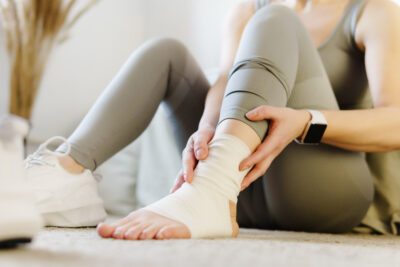Understanding Osteoporosis-Related Fractures: What You Need to Know

Osteoporosis, the most common bone disorder in the world, is a condition where your bones become weak, brittle, and more likely to break.
For years, osteoporosis was thought to be just a natural part of aging, but we now know it’s a condition that can be managed and treated.
When you have osteoporosis, your body’s natural process of breaking down and rebuilding bone becomes unbalanced. This often happens due to hormonal changes, aging, or lifestyle factors. As a result, your bones become fragile, making fractures more likely — especially in your hips, spine, and wrists. For older adults, these fractures can be life-changing.
Who’s At Risk?
If you’re over 50, the numbers are eye-opening. More than half of all women and up to 25% of men over 50 will experience a fracture due to osteoporosis. As people age, the likelihood of fractures increases, making early detection and prevention essential.
HOW TO CHECK YOUR RISK OF FRACTURES
Detecting osteoporosis early is one of the best ways to prevent fractures.
Here’s how doctors assess your risk:
- Bone Density Test (DXA Scan) This scan measures how dense your bones are. This test is essential for diagnosing osteoporosis and tracking how well treatments are working. It’s quick, painless, and feels similar to an X-ray. If your score is -2.5 or lower, you have osteoporosis.
- Fracture Risk Calculators Tools like FRAX®, QFracture, and the Garvan Fracture Risk Calculator estimate your chance of breaking a bone within the next 5 to 10 years. These tools use your age, bone density, medical history, and other factors to give a clear picture of your fracture risk.
- Other Risk Factors Your risk of fractures increases if you have any of the following:
- A history of fractures
- Family history of osteoporosis
- Use of certain medications (like steroids)
- Smoking or heavy alcohol use
- Medical conditions like rheumatoid arthritis
How to Protect Your Bones and Avoid Fractures
While you can’t change some risk factors like age or family history, there’s a lot you can do to protect your bones and prevent fractures.
- Reduce Your Risk of Falls Falls are one of the biggest causes of fractures, especially as you age. Here’s how to stay on your feet:
- Make Your Home Safer: Add grab bars in the bathroom, improve lighting, and remove clutter or tripping hazards.
- Improve Your Balance and Strength: Activities like tai chi and physical therapy help you stay steady on your feet.
- Review Your Medications: Some medications make you dizzy or drowsy. Talk to your doctor to see if adjustments are needed.
- Eat for Strong Bones Make sure you’re getting enough calcium and vitamin D. Calcium strengthens bones, while vitamin D helps your body absorb it. You can get calcium from dairy, leafy greens, and fortified foods. Vitamin D comes from sunlight, but supplements may be necessary if you’re not getting enough.
- Stay Active Weight-bearing exercises like walking, jogging, climbing stairs, or dancing help build and maintain bone. Resistance training, like lifting weights, also strengthens muscles and improves balance.
- Avoid Smoking and Limit Alcohol Smoking speeds up bone loss, while drinking too much alcohol can weaken your bones. Quitting smoking and drinking in moderation can make a big difference in your bone health.
Treatment Options
If you’ve been diagnosed with osteoporosis, treatment options can help reduce your bone loss, build new bone, and lower your risk of fractures.
Here are the most common treatment options:
- Calcium and Vitamin D If you’re not getting enough calcium and vitamin D from your diet, your doctor may recommend supplements. These two nutrients are essential for bone strength.
- Medications Medications can slow down bone loss, increase bone density, and reduce the risk of fractures. Here are the most common types
-
- Bisphosphonates slow down the cells that break down bone. Examples include alendronate, risedronate, and zoledronate.
- Denosumab is an injection that blocks the cells responsible for bone loss. It’s a good option for people who can’t take bisphosphonates.
- Selective estrogen receptor modulators (SERMs) mimic estrogen’s effects on bones, helping to prevent bone loss.
- Unlike other treatments, parathyroid hormone (PTH) analogues help your body build new bone. They’re often used for people with severe osteoporosis.
- Emerging Treatments New treatments are being developed all the time. They include:
-
- Biologic Medications: These medications target proteins that affect bone metabolism.
- Personalized Treatment Plans: Instead of a one-size-fits-all approach, doctors are tailoring treatments based on a person’s fracture risk, age, and health history.
When Should You See a Specialist?
If you’re over 65 (for women) or 75 (for men), it’s time to talk to a healthcare provider about your fracture risk. But even if you’re younger, you should see a specialist if you:
-
- Had a fracture from a minor fall or injury
- Have a family history of osteoporosis
- Take medications that weaken bones (like steroids)
What To Expect At Your Appointment
- Health Review: Your doctor will ask about your medical history, lifestyle, and any history of fractures.
- Bone Density Test: If needed, you’ll get a DXA scan to check your bone strength.
- Treatment Plan: Your doctor will recommend steps to protect your bones. This might include lifestyle changes, supplements, or medications.
Living Well With Osteoporosis
If you’ve been diagnosed with osteoporosis, it’s natural to feel concerned. But with the right steps, you can live a healthy, active life. Focus on building stronger bones, preventing falls, and following your treatment plan. Your doctor can guide you every step of the way.
Early action can prevent fractures and keep you moving with confidence. If you’re ready to take control of your bone health, click here or call 855-898-2655 to schedule a screening at Direct Orthopedic Care (DOC). Our Dallas-area offices are conveniently located and open 7 days a week.
Sources: National Institutes of Health, Cleveland Clinic, American Academy of Orthopedic Surgeons




